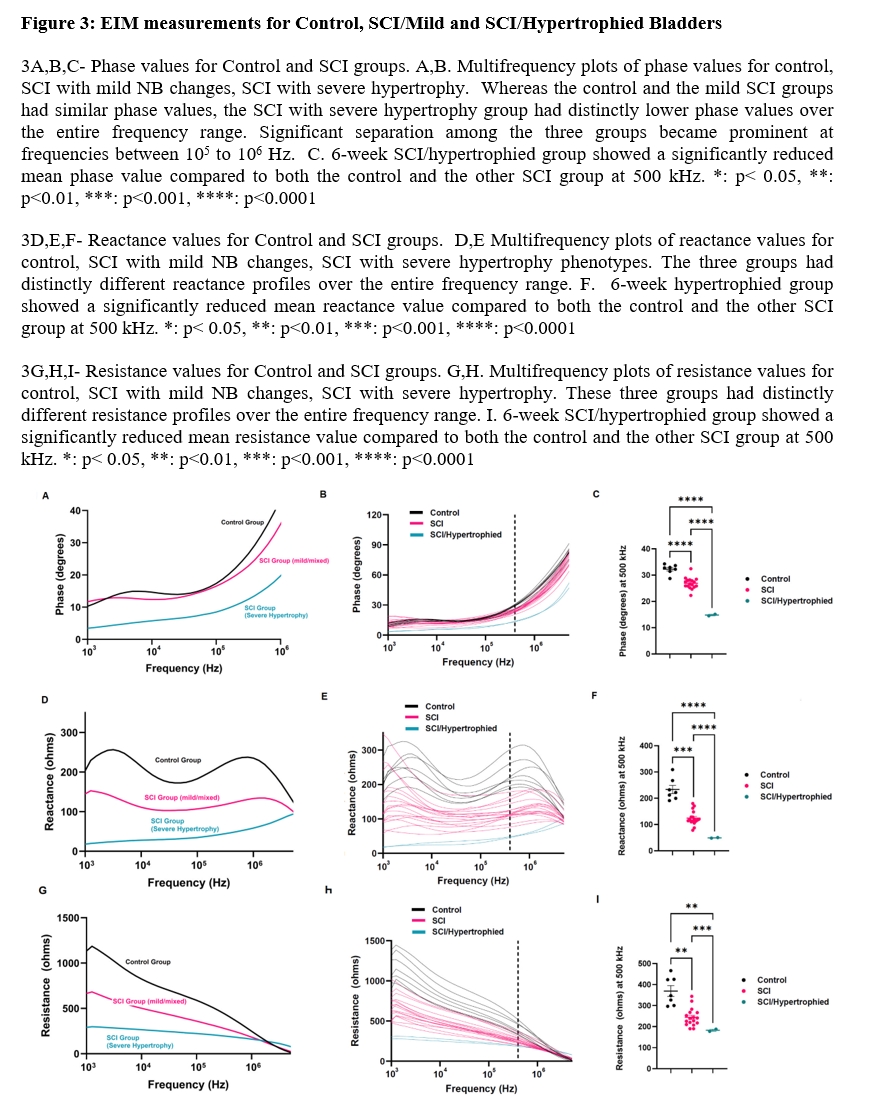Novel Phenotype Characterization Utilizing Electrical Impedance Myography Signatures In Murine Spinal Cord Injury Neurogenic Bladder Models
Hsin-Hsiao Scott Wang, MD, MPH, MBAn1, Hatim Thaker, MD1, Alex Bigger-Allen, PhD1, Janice Nagy, PhD2, Seward Rutkove, MD2.
1Boston Children's Hospital, Boston, MA, USA, 2Beth Israel Deaconess Medical Center, Boston, MA, USA.
BACKGROUND: Neurogenic bladder (NB) results in various upper and lower urinary tract symptoms and complications. Urodynamic study (UDS) is the gold standard to evaluate and monitor bladder function in NB patients. However, UDS is associated with significant inter-observer variability due to arbitrarily defined metrics. Electric impedance myography (EIM) is a quantitative technique that was developed for evaluation of neuromuscular disorders. We sought to investigate whether differences in EIM signatures were present in NB versus control animals in a murine spinal cord injury (SCI) model.
METHODS: In total, 28 female, 8-10 weeks old, C57BL/6J mice were used. Twenty underwent spinal cord transection; 8 were used as healthy controls. One cohort of mice was euthanized approximately 4 weeks after the spinal cord transection. Each bladder was measured in situ with an EIM probe and impedance values (phase, reactance and resistance) were recorded from 1 kHz to 10 MHz (Figure 1). The bladder tissue was then processed for molecular and histologic study. A small cohort of mice was euthanized 6 weeks after spinal cord transection for subgroup analysis.
RESULTS: SCI mice were found to have significantly higher bladder-to-body weight ratio (p<0.0001), more collagen deposition in detrusor (integrated density 1.9X more in SCI vs control, p=0.009), and higher smooth muscle myosin heavy chain isoform A to B ratio (32.5 in SCI vs 1 in control, p<0.0001) as shown in Figure 2.The EIM measurements in SCI and control group are shown in Figure 3. Compared with the control group, the SCI group was associated with significantly lower phase, reactance, and resistance values across much of the frequency spectrum. We found by gross examination and histology that SCI yielded two distinct detrusor phenotypes (i.e. severe hypertrophy and dilated). The severely hypertrophied bladder detrusor phenotype was found in the 6-week subgroup of SCI mice, and was characterized by even higher bladder-to-body weight ratio and more depressed EIM values. For example, at 500 kHz the impedance results included: lower phase values (mean SCI/hypertrophied 15±0.4° vs SCI 26±2° vs control 32±2°, p<0.0001), lower reactance values (mean SCI/hypertrophied 50±1Ω vs SCI 125±27Ω vs control 233±42Ω, p<0.0001), and lower resistance values (mean SCI/hypertrophied 183±7Ω vs SCI 244±42Ω vs control 370±68Ω, p<0.0001).Significant correlations (p<0.001) between bladder-to-body weight ratios and all three EIM measurements were obtained at selected frequencies spanning the entire frequency spectrum.
CONCLUSIONS: Our study demonstrated distinct bladder phenotypical changes with associated alterations in EIM measurements in the bladders of mice with SCI. EIM can potentially provide a promising alternative for non-invasive and real-time evaluation of disease progression and treatment response in NB subjects.



Back to 2023 Abstracts
